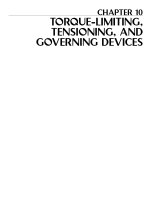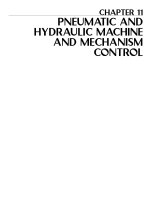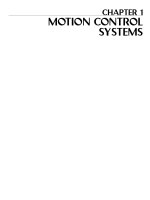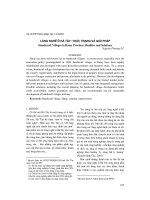Figliola beasley mechanical measurements 4th solutions
Bạn đang xem bản rút gọn của tài liệu. Xem và tải ngay bản đầy đủ của tài liệu tại đây (3.01 MB, 519 trang )
SOLUTION MANUAL
www.elsolucionario.net
PROBLEM 1.1
FIND: Explain the hierarchy of standards. Explain the term standard. Cite example.
SOLUTION
The term standard refers to an object or instrument, a method or a procedure that provides a
value of an acceptable accuracy for comparison.
A primary standard defines the value of the unit to which it is associated. Secondary
standards, while based on the primary standard, are more readily accessible and amenable
for use in a calibration. There is a hierarchy of secondary standards: A transfer standard
might be maintained by a national standards lab (such as NIST in the United States) to
calibrate industrial “laboratory standards”. It is costly and time-consuming to certify a
laboratory standard, so they are treated carefully and not used too regularly. A laboratory
standard would be maintained by a company to be used to certify a more common in-house
reference called the working standard. A working standard would be calibrated against the
laboratory standard. The working standard is used on a more regular basis to calibrate
everyday measurement devices or products being manufactured. Working standards are more
the norm for most of us. A working standard is simply the value or instrument that we
assume is correct in checking the output operation of another instrument.
Example: A government lab maintains the primary standard for pressure. It calibrates a an
instrument called a “deadweight tester” (see C9 discussion) for high pressure calibrations.
These form its transfer standard for high pressure. A company that makes pressure
transducers needs an in-house standard to certify their products. They purchase two
deadweight testers. They send one tester to the national lab to be calibrated; this becomes
their laboratory standard. On return, they use it to calibrate the other; this becomes their
working standard. They test their manufactured transducers using the working standard –
usually at one or two points over the transducer range to assure that it is working. Because
the working standard is being used regularly, it can go out of calibration. Periodically, they
check the working standard calibration against the laboratory standard.
See ASME PTC 19.2 Pressure Measurements for a further discussion.
A test standard defines a specific procedure that is to be followed.
www.elsolucionario.net
PROBLEM 1.2
FIND: Why calibrate? What does calibrated mean?
SOLUTION:
The purpose of a calibration is to evaluate and document the accuracy of a measuring device.
A calibration should be performed whenever the accuracy level of a measured value must be
ascertained.
An instrument that has been calibrated provides the engineer a basis for interpreting the
device’s output indication. It provides assurance in the measurement. Besides this purpose, a
calibration assures the engineer that the device is working as expected.
A periodic calibration of measuring instruments serves as a performance check on those
instruments and provides a level of confidence in their indicated values. A good rule is to
calibrate measuring systems annually or more often as needed.
ISO 9000 certifications have strict rules on calibration results and the frequency of
calibration.
www.elsolucionario.net
PROBLEM 1.3
FIND: Suggest methods to estimate the accuracy and random and systematic errors of a
dial thermometer.
SOLUTION:
Random error is related to repeatability: how closely an instrument indicates the same value.
So a method that repeatedly exposes the instrument to one or more known temperatures
could be developed to estimate the random error. This is usually stated as a statistical
estimate of the variation of the readings. An important aspect of such a test is to include
some mechanism to allow the instrument to change its indicated value following each
reading so that it must readjust itself.
For example, we could place the instrument in an environment of constant temperature and
note its indicated value and then move the instrument to another constant temperature
environment and note its value there. The two chosen temperatures could be representative of
the range of intended use of the instrument. By alternating between the two constant
temperature environments, differences in indicated values within each environment would be
indicative of the precision error to be expected of the instrument at that temperature. Of
course, this assumes that the constant temperatures do indeed remain constant throughout the
test and the instrument is used in an identical manner for each measurement.
Systematic error is a fixed offset. In the absence of random error, this would be how closely
the instrument indicates the correct value. This offset would be present in every reading. So
an important aspect of this check is to calibrate it against a value that is at least as accurate as
you need. This is not trivial.
For example, you could use the ice point (0oC) as a check for systematic error. The ice point
is formed from a carefully prepared bath of solid ice and liquid water. As another check, the
melting point of a pure substance, such as silver, could be used. Or easier, the steam point.
Accuracy requires a calibration to assess both random and systematic errors. If in the
preceding test the temperatures of the two constant temperature environments were known,
the above procedure could serve to establish the systematic error, as well as random error of
the instrument. To do this: The difference between the average of the readings obtained at
some known temperature and the known temperature would provide an estimate of the
systematic error.
www.elsolucionario.net
PROBLEM 1.4
FIND: Discuss interference in the test of Figure 1.3
SOLUTION :
In the example described by Figure 1.3, tests were run on different days on which the local
barometric pressure had changed. Between any two days of different barometric pressure, the
boiling point measured would be different – this offset is due to the interference effect of the
pressure.
Consider a test run over several days coincident with the motion of a major weather front
through the area. Clearly, this would impose a trend on the dataset. For example, the
measured boiling point may be seem as increasing from day to day.
By running over random days separated by a sufficient period of days, so as not to allow any
one atmospheric front to impose a trend on the data, the effects of atmospheric pressure can
be broken up into noise. The measured boiling point might then be high one test but then low
on the next, in effect, making it look like random data scatter, i.e. noise.
www.elsolucionario.net
PROBLEM 1.5
FIND: How does resolution affect accuracy?
SOLUTION
The resolution of a scale is defined by the least significant increment or division on the
output display. Resolution affects a user's ability to resolve the output display of an
instrument or measuring system.
Consider a simple experiment to show the effects of resolution. Under some fixed condition,
ask several competent, independent observers to record the indicated value from a
measurement system. Collect the results – this becomes your dataset. Because the indicated
value is the same for each observer, the scatter in your dataset will be close to the value of
the resolution of the measurement system.
Data scatter contributes to the random error. As such, the output resolution of a measurement
system forms a lower limit as to the random error to be expected.
The resolution would not contribute to systematic error. Systematic error is an offset.
www.elsolucionario.net
PROBLEM 1.6
FIND: How does hysteresis affect accuracy?
SOLUTION
Hysteresis error is the difference between the values indicated by a measurement system
when the value measured is increasing in value as opposed to when it is decreasing in value;
this despite the fact that the value being measured is actually the same for either case.
A common cause of hysteresis in analog instruments is friction in the moving parts. This can
cause the output indicator to 'stick'. In digital instruments, hysteresis can be caused by the
discretization.
If hysteresis error is ignored, the effect on any single measurement can be seen as a
systematic error. On multiple measurements in any one direction, the effect can be to impose
a 'trend' on the data set. The use of randomization methods can break up the trends
incorrectly implied by hysteresis effects. Randomization makes systematic errors behave as
random errors, which are more easily interpreted. If randomization methods are not used, the
hysteresis effect behaves as a systematic error.
PROBLEM 1.7
SOLUTION
This problem is open-ended and has no unique solution. We suggest that the instructor use
this Problem as the basis for an in-class or small group discussion.
www.elsolucionario.net
PROBLEM 1.8
FIND: Identify measurement stages for each device.
SOLUTION
a)
thermostat
Sensor/transducer: bimetallic thermometer
Output: displacement of thermometer tip
Controller: mercury contact switch (open:furnace off; closed:furnace on)
b)
speedometer
Method 1:
Sensor: usually a mechanically coupled cable
Transducer: typically a dc generator that is turned by the cable producing an electrical
signal
Output: typically a pointer/scale (note: often a galvanometer is used to convert the
electrical signal in a mechanical rotation of the pointer)
Method 2:
Sensor: A magnet attached to the rotating shaft
Transducer: A Hall Effect device that is stationary but detects each sensor passage by
creating voltage pulse
Signal Conditioning: A pulse counting circuit; maybe also digital-analog converter (if
analog readout is used)
Output: An analog or digital readout calibrated to convert pulses per minute to kph or
mph.
c)
Portable CD Stereo Player
Sensor: laser with optical reader (reflected light signal differentiates between a "1" and
"0")
Transducer: digital register (stores digital information for signal conditioning)
Signal conditioning: digital-to-analog converter and amplifier (converts digital numbers
to voltages and amplifies the voltage)
Output: headset/speaker (note: the headeset/speaker is a second transducer in this system
converting an electrical signal back to a mechanical displacement)
www.elsolucionario.net
d)
anti-lock braking system
Sensor: brake activation switch senses brakes 'on'; encoder counts wheels revolutions per
unit time
Signal conditioning: timing circuit
Output: a feedback signal that pulsates brake action overriding the driver's constant pedal
pressure
e)
audio speaker
Sensor: coil (to which the input terminals are connected)
Transducer: coil-magnet-speaker cone that acts as a miniature electrical dc motor
responding to changes in current applied.
Output: speaker cone displacement
www.elsolucionario.net
PROBLEM 1.9
KNOWN: Data of Table 1.5
FIND: input range, output range
SOLUTION
By inspection
0.5 ≤ x ≤100 cm
0.4 ≤ y ≤ 253.2 V
The input range (x) is from 0.5 to 100 cm. The output range (y) is from 0.4 to 253.2V. The
corresponding spans are given by
ri = 99.5 cm
ro = 252.8 V
COMMENT
Note that each answer has units shown. By themselves, numerical answers are meaningless.
Always show units for data, for each step of data reduction and in all reported results.
www.elsolucionario.net
PROBLEM 1.10
KNOWN: Data set of Table 1.5
FIND: Discuss advantages of different plot formats for this data
SOLUTION:
Both rectangular and log-log plots are shown below.
Rectangular grid (left plot below):
An advantage of this format is that is displays the data clearly as having a non-linear
relationship. The data trend, while not immediately quantifiable, is established.
A disadvantage with this data set is that the poor resolution at low x values makes
quantification at low values difficult.
Log-log grid (right plot below):
An advantage of this format with this particular data set is that the data display a linear
relationship of the form: log y = m log x + log b. This tells us that the data have the
relationship, y = bxm. Because of these facts, resolution is equally good over the whole scale.
A disadvantage with this format is that one must remember the data has been conditioned to
look linear. We are no longer plotting x versus y. This is particularly important to remember
when attempting to find the slope of y against x.
P1.10
P1.10
300
1000
250
100
Y[V]
Y[V]
200
150
100
10
1
50
0.1
0
0
50
X[cm]
100
www.elsolucionario.net
0.1
1
10
X[cm]
100
PROBLEM 1.11
KNOWN: Calibration data of Table 1.5
FIND: K at x = 5, 10, 20 cm
SOLUTION:
The data reveal a linear relation on a log-log plot suggesting y = bxm. That is:
log y = log (bxm) = log b + m log x
Y = B + mX
or
From the plot, B = 0, so that b = 1, and m = 1.2. Thus, we find from the calibration the
relationship
y = x1.2
Because K = [dy/dx]x = 1.2x0.2, we obtain
P1.11
K [V/cm]
1.66
1.90
2.18
1000
100
Y[V]
x [cm]
5
10
20
We should expect that errors would
propagate with the same sensitivity as the
data. Hence for y=f(x), as sensitivity
increases, the influence of the errors on y
due to errors in x between would increase.
10
1
0.1
0.1
1
10
100
X[cm]
COMMENT
A common shortcut is to use the approximation that
dy/dx = lim x→0 ∆y/∆x
This approximation is valid only for very small changes in x, otherwise errors result. This is a
common mistake. An important aspect of this problem is to draw attention to the fact that
many measurement systems may have a static sensitivity that is dependent on input value.
www.elsolucionario.net
PROBLEM 1.12
KNOWN: Sequence calibration data set of Table 1.6
ri = 5 mV
ro = 5 mV
FIND:
%(eh)max
SOLUTION
By inspection of the data, the maximum hysteresis occurs at x = 3.0. For this case,
eh = (eh)max = yup - ydown
= 0.2 mV
or
%(eh)max = 100 x (0.2 mV/5 mV)
= 4%
P1.12
5
Y[mV]
4
3
2
1
0
0
2
4
X[mV]
www.elsolucionario.net
Problem 1.13
KNOWN: Comparison of three clock outputs with standard time
FIND: Discuss estimated accuracy
SOLUTION
Clock A shows a bias error of 2:23 s. The bias would appear to be increasing at a rate of 1
s/hr. However, clock resolution is 1 s which by itself can lead to precision error (data scatter)
of ± ½ s; this can create the situation noted here. Another reading would clarify this.
Clock B shows a bias error of 5 s. There does not appear to be any precision error in the
output.
Clock C shows a 0 s bias error and a precision error on the order of ± 2 s.
Because of the calibration, we now know the values of bias error for each clock. Correcting
for bias error, we can consider Clock B to provide the more accurate time. Over time, the
bias error in Clock A could become cumbersome to deal with, that is if the bias is indeed
increasing in time. Therefore, it provides the least reliable value of time.
www.elsolucionario.net
PROBLEM 1.14
SOLUTION
Each curve is plotted below in a suitable format to yield a linear shape.
(a)
100
(b)
14
12
1
10
0.1
8
Y
Y[V]
10
6
0.01
4
0.001
0.0001
0.01
2
0
0.1 X[m]
1
10
0
2
4
6
8
10
(d)
(c)
10
X
1.E+05
1.E+03
Y
1.E+01
Y
1
1.E-01
1.E-03
1.E-05
1.E-07
0.1
1
X
10
0.01
0.1
(e)
1.E+02
1.E+00
1.E-02
Y
0.1
0.01
1.E-04
1.E-06
1.E-08
0
2
4
X
6
www.elsolucionario.net
8
10
X
1
10
PROBLEM 1.15
KNOWN: y = 10e-5x
FIND: Slope at x = 0, 2 and 20
SOLUTION
The equation has been plotted below. The slope of the equation at any value of x can be
found graphically or by the derivative
dy/dx = -50e-5x
x [V] dy/dx [V/unit]
0
2
20
-50
-0.00227
0
The sensitivity of y to x decreases with x.
COMMENT
An important aspect of this problem, is to draw attention to the fact that many measurement
systems may have a static sensitivity that is dependent on input value. While it is desirable to
have a constant K value, the operating principle of many systems will preclude this or
incorporate signal conditioning stages to overcome such nonlinearity. In Chapter 3, the
concept that system's also have a dynamic sensitivity that is frequency dependent will be
introduced.
P1.15
y [V]
10
1
0.1
0.01
0
10
X [units]
www.elsolucionario.net
20
PROBLEM 1.16
SOLUTION
The data are plotted below. The slope of a line passing through the data is 1.365 and the y
intercept is 2.12. The data can be fit to the line y = 1.365x +2.12. Therefore, the static
sensitivity is K = 1.365 for all x.
P1.16
10
Y [V]
8
6
4
2
0
0
2
X [V]
www.elsolucionario.net
4
6
PROBLEM 1.17
KNOWN: Data of form y = axb.
FIND: a and b; K
SOLUTION
The data are plotted below. If y = axb, then in log-log format the data will take the linear
form
log y = log a + b log x
A more or less linear curve results with this data. From the plot, the curve fit found is
log y = -0.23 + 2x
This implies that
y = 0.59x2
so that a = 0.59 and b = 2. The static sensitivity is found by the slope dy/dx at each value of
x.
x [m]
0.5
2.0
5.0
10.0
K(x1) = dy/dx x1 [cm/m]
0.54
2.16
5.40
10.80
COMMENT
An aspect of this problem is to draw attention to the fact that many measurement systems
may have a static sensitivity that is dependent on input value. The operating principle of
many systems will determine how K behaves.
p1.17
y [cm]
100
10
1
0.1
0.1
1
X [m]
www.elsolucionario.net
10
PROBLEM 1.18
KNOWN: Calibration data
FIND: Plot data. Estimate K.
SOLUTION
The data are plotted below in semi-log format. A linear curve results.
This suggests y = aebx. Plotting y vs x in semi-log format is equivalent to
plotting
log y = log a + bx
From the plot, a = 5 and b = -1. Hence, the data describe y = 5e-x. Now, K =
dy/dx x, so that
X [psi]
K
0.05
0.1
0.5
-4.76
-4.52
-3.03
1.0
-1.84
The magnitude of the static sensitivity decreases with x. The negative sign indicates that y
will decrease as x increases.
COMMENT
An aspect of this problem is to draw attention to the fact that many measurement systems
may have a static sensitivity that is dependent on input value. The operating principle of
many systems will determine how K behaves.
P1.18
10
Y [cm]
y=5exp(-x)
1
0
0.5
X [kPa]
1
www.elsolucionario.net
1.5
PROBLEM 1.19
KNOWN: A bulb thermometer is used to measure outside temperature.
FIND: Extraneous variables that might influence thermometer output.
SOLUTION
A thermometer's indicated temperature will be influenced by the temperature of solid objects
to which it is in contact, and radiation exchange with bodies at different temperatures
(including the sky or sun, buildings, people and ground) within its line of sight. Hence,
location should be carefully selected and even randomized. We know that a bulb
thermometer does not respond quickly to temperature changes, so that a sufficient period of
time needs to be allowed for the instrument to adjust to new temperatures. By replication of
the measurement, effects due to instrument hysteresis and instrument and procedural
repeatability can be randomized.
Because of limited resolution in such an instrument, different competent temperature
observers might record different indicated temperatures even if the instrument output were
fixed. Either observers should be randomized or, if not, the test replicated. It is interesting to
note that such a randomization will bring about a predictable scatter in recorded data of about
½ the resolution of the instrument scale.
www.elsolucionario.net
PROBLEM 1.20
KNOWN:
Input voltage, (Ei) and Load (τL) can be controlled and varied.
Efficiency (η), Winding temperature (Tw), and Current (I) are measured.
FIND: Specify the dependent, independent in the test and suggest any extraneous variables.
SOLUTION
The measured variables are the dependent variables in the test and they depend on the
independent variables of input voltage and load. Several influencing extraneous variables
include: ambient temperature (Ta) and relative humidity R; Line voltage fluctuations (e); and
each of the individual measuring instruments (mi). The variation of the independent variables
should be performed separately maintaining one independent variable fixed while the other is
systematically varied over the test range. A random test procedure for the independent
variable will randomize the effects of Ta, R and e. Replication methods using different test
instruments would be one way to randomize the effects of the mi; alternatively, calibration of
all measuring instruments would provide a good degree of control over these variables.
η= η(EI, τL; Ta, R, e, mi)
Tw = Tw(Ei, τL ;Ta, R, e, mi)
I = I(Ei, τL ; Ta, R, e, mi)
www.elsolucionario.net
PROBLEM 1.21
KNOWN:
Specifications Table 1.1
Nominal pressure of 500 cm H2O to be measured.
Ambient temperature drift between 18 to 25 oC
FIND: Magnitude of each elemental error listed.
SOLUTION
Based on the specifications:
ri = 1000 cm H2O
ro = 5 V
Hence, K = 5 V/ 1000 cm H2O = 5 mV/cm H2O. This gives a nominal output at 500 cm H2O
input of 2.5 V. This assumes that the input/output relation is linear over range but we are told
that it is linear to within some linearity error.
linearity error = eL = (±0.005) (1000 cm H2O)
= ± 5 cm H2O
= ± 0.025 V
hysteresis error = eh = (±0.0015)(1000 cm H2O)
= ±1.5 cm H2O
= ±0.0075 V
sensitivity error = eK = (±0.0025)(500 cm H2O)
= ± 0.75 cm H2O = ± 0.00375 V
thermal sensitivity error = (±0.0002)(7oC)(500 cm H2O)
= ±0.7 cm H2O
= ± 0.0035 V
thermal drift error = (0.0002)(7oC)(1000 cm H2O)
= 1.4 cm H2O
= 0.007 V
overall instrument error = (52+1.52+0.752+0.72+1.42)1/2 = 5.501 cm H2O
www.elsolucionario.net
PROBLEM 1.22
KNOWN: FSO = 1000 N
FIND: ec
SOLUTION
From the given specifications, the elemental errors are estimated by:
eL = 0.001 x 1000N = 1N
eH = 0.001 x 1000N = 1N
eK = 0.0015 x 1000N = 1.5N
ez = 0.002 x 1000N = 2N
The overall instrument error is estimated as:
ec = (12 + 12 + 1.52 + 22)1/2 = 2.9N
COMMENT
This root-sum-square (RSS) method provides a "probable" estimate (i.e. the most likely
estimate) of the instrument error possible in any given measurement. "Possible" is a big word
here as error values will most likely change between measurements.
www.elsolucionario.net
PROBLEM 1.23
SOLUTION
Repetition through repeated measurements made under a fixed set of operating conditions
provides a measure of the time (or spatial) variation of a measured variable.
Replication through the duplication of tests conducted under similar operating conditions
provides a measure of the effect of control of the operating conditions on the measured
variable.
Repetition refers to repeating the measurement during a test.
Replication refers to repeating the test (to repeat the measurements).
PROBLEM 1.24
SOLUTION
Replication is used to assess the ability to control any aspect of a test or its operating
condition. Repeat the test resetting the operating conditions to their original set points.
PROBLEM 1.25
SOLUTION
Randomization is used to break-up the effects of interference from either continuous or
discrete extraneous (i.e. uncontrolled) variables.
PROBLEM 1.26
SOLUTION
This problem does not have a unique solution. We suggest that the instructor use this
problem as a basis for an in-class or small group discussion.
www.elsolucionario.net









